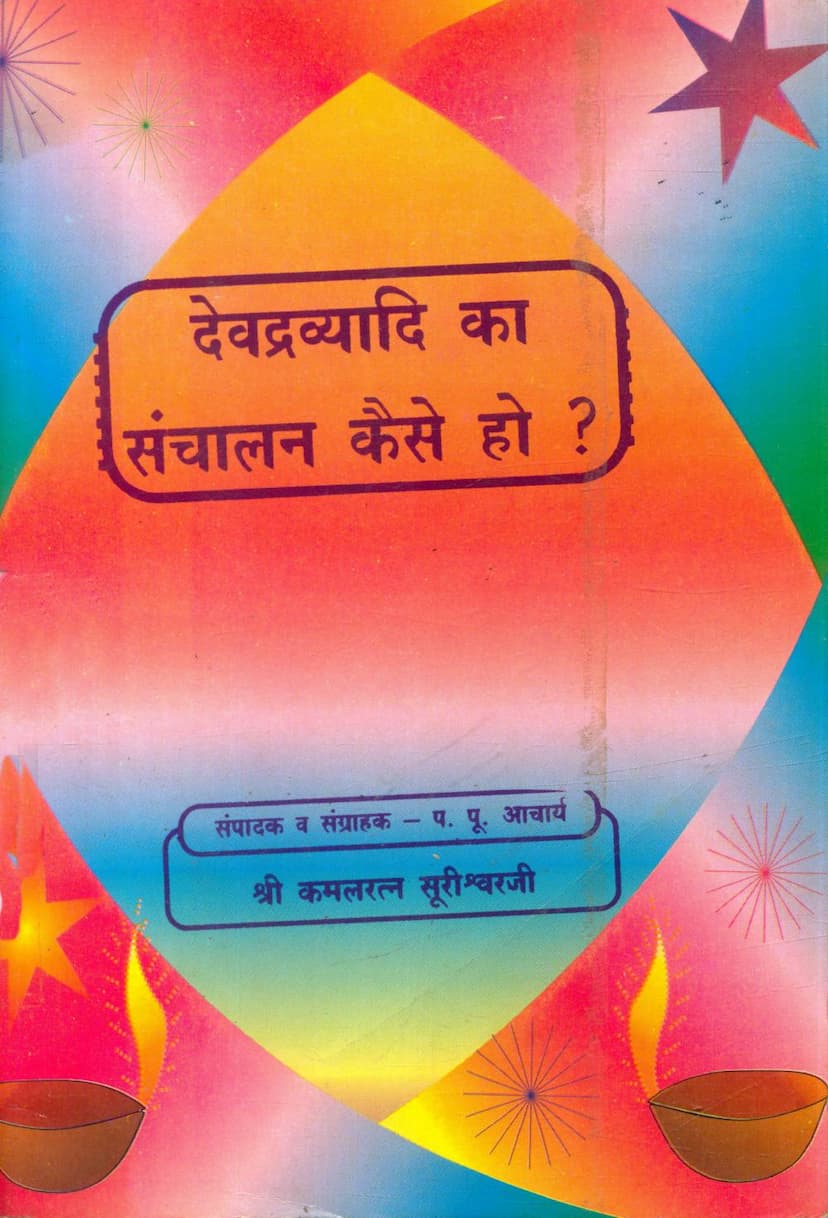Devdravyadi Ka Sanchalan Kaise Ho
Added to library: September 1, 2025

Summary
This document is a Jain religious text titled "Devdravyadi Ka Sanchalan Kaise Ho?" (How to Manage Devotional Funds and Similar Assets?) authored and compiled by Acharya Shri Kamalratnasuri. Published by Adhyatmik Prakashan Samstha, it provides extensive guidance on the proper handling and utilization of various categories of Jain religious funds.
Here's a comprehensive summary of its key points:
Core Purpose and Motivation: The book aims to address the widespread misuse and mismanagement of Devdravya (funds dedicated to deities and religious institutions) due to ignorance or stinginess. The author emphasizes the severe karmic consequences of such actions and seeks to provide clear, scripturally-based guidance to prevent devotees from incurring the sin of "Devdravya bhakshan" (consuming or misusing devotional funds).
Key Principles and Concepts:
- Categorization of Funds: The book meticulously outlines and explains the nature and intended use of various categories of religious funds, highlighting their sanctity and the strict rules governing their expenditure.
- Devdravya (Devotional Funds): This is the primary focus. It includes funds collected for:
- Jinpratima (Idols): Funds specifically offered for the worship, adornment (like keshara, chandana), and upkeep of idols. This money is strictly for idol-related expenses and cannot be used elsewhere.
- Jinmandir (Temples): Funds collected during various Kalyanaks (auspicious events related to Tirthankaras like conception, birth, renunciation, enlightenment, and liberation), bolis (auctions or bids) for services or items in the temple, and donations for temple construction or renovation.
- Jinam Aagam (Sacred Scriptures): Funds collected through bolis for scriptural rituals, learning, or purchasing religious texts.
- Sadhu/Sadhvi (Monks/Nuns): Funds collected for the service and upkeep of ascetics.
- Shravak/Shravika (Male/Female Devotees): Funds intended for the welfare and support of devotees.
- Guru Dravya (Funds for Spiritual Teachers): Funds dedicated to the service and respect of spiritual preceptors.
- Mandir Sadharan (General Temple Funds): Funds for the general maintenance and operational expenses of the temple, including salaries for priests and staff, and purchasing worship materials.
- Sadharan Dravya (General Funds): Funds that can be used for various religious activities, including supporting other religious categories when they are in need, but strictly for religious purposes and not for personal or secular use.
- Other Categories: The book also details funds for specific vows like Aayambil Tap, upavasa, vachnavali, swami vatsalya, Navkashi, Paushadh, etc.
- Prohibition of Misuse: A recurring theme is the absolute prohibition of using Devdravya for personal benefit, for secular education, for charity to the general public or non-Jains, or for any purpose not directly related to the specific category of fund.
- Strict Accounting: The importance of maintaining separate accounts and "kothlis" (containers or ledgers) for each category of funds is stressed to prevent commingling and misuse.
- Timely Deposit of Boli Amounts: Individuals who bid for religious services or items must deposit the amount immediately to avoid incurring the sin of Devdravya bhakshan and to ensure the proper accrual of interest for religious purposes.
- Role of Trustees: Trustees have a crucial duty to act according to scriptures, ensure timely collection and deposit of funds, maintain temple premises, attend to the needs of ascetics, and actively promote religious activities. They are warned against inactivity, self-interest, and disputes that can harm the Jain tradition.
- No "Clean Advance": It is strongly advised not to give "clean advance" (unsecured loans) from Devdravya. Instead, valuable assets should be taken as collateral.
- Repentance and Rectification: The book emphasizes that even unintentional misuse can have severe consequences, and proactive efforts should be made to rectify any errors and prevent future transgressions.
- Scriptural Authority: The author consistently refers to various Jain scriptures and the pronouncements of revered Acharyas to support the guidelines provided.
- Consequences of Misuse: The text details severe karmic repercussions for misusing Devdravya, including rebirth in lower realms, poverty, suffering, and hindered spiritual progress. It provides illustrative stories (like that of Devsen Sheth's mother and Shubhankar Sheth) to underscore these warnings.
- Specific Rulings: The book addresses specific issues like:
- Whether Swapna (dreams of Tirthankaras) income is Devdravya (the consensus is yes, as they are related to Tirthankaras' Kalyanaks).
- Whether Guru Puja funds are Devdravya (generally yes, and should be used for temple upkeep or construction, not directly for guru's personal needs).
- Whether priests can be paid from Devdravya (only in exceptional cases where no other funds are available, and preferably from general funds or the devotee's own wealth).
- The prohibition of using Devdravya for personal benefit, even indirectly (e.g., living in a Devdravya-funded house without proper rent).
Overall Message: "Devdravyadi Ka Sanchalan Kaise Ho?" serves as a comprehensive manual and a strong cautionary guide for all Jain devotees and trustees involved in managing religious funds. It stresses the paramount importance of adherence to scriptural injunctions, transparency, and diligent stewardship of Devdravya to foster spiritual growth, uphold the Jain faith, and avoid severe karmic repercussions. The book advocates for a selfless approach, prioritizing the sanctity and proper utilization of these sacred funds for the benefit of the religion and its followers.